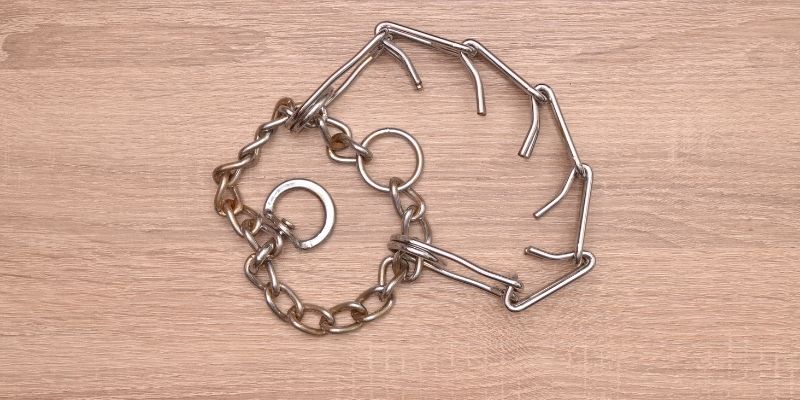Prong collars are not for everyone. Many dog owners may be afraid of prong collars because they seem only to have negative side effects, but prong collars can also have positive aspects that many people neglect to mention. This article will explore the pros and cons of prong collar usage on dogs so you can make an informed decision about whether or not this type of restraint is right for your pet.
Do you have a specific question about prong collars? Then use the table of contents below to jump to the most relevant section. And you can always go back by clicking on the black arrow in the right bottom corner of the page. Also, please note that some of the links in this article may be affiliate links. For more details, check the Disclosure section at the bottom of the page.
Here's what we'll cover:
- How Does A Prong Collar work?
- Why Should I Use a Prong Collar?
- Which Behavioral Problems Can It Help With?
- Finding The Prong Collar that is the Right Fit for Your Pup
- Are Prong Collars Safe For My Dog?
- Common Errors in Using and Wearing Prong Collar
- Are Prong Collars Humane?
- Using Prong Collar on Aggressive Dogs
How Does A Prong Collar work?
To begin with, we must understand the behavior and actions of a puppy’s mother when her pups are only a few weeks old. When the puppy disobeys her in her eyes, the mother will physically bite her puppy on the back of their neck. And perhaps even pick them up to put them in their place! The puppy may wail for a few seconds, but no long-term damage has occurred.
The prong collar replicates the sensation of the mother biting her puppy when she bites her dog. However, it is designed to deliver equal pressure across the dog’s neck because we can regulate the amount of force used.
Why Should I Use a Prong Collar?
Training a prong collar will help you establish rules and boundaries for your dog, which they need and desire. They will assist you in regaining control over your dog rather than the other way around!
Which Behavioral Problems Can It Help With?
Prong collars can aid with a range of behavioral issues in dogs. As a result of being trained using a prong collar, your dog may become more balanced and confident.
Finding The Prong Collar that is the Right Fit for Your Pup
When mishandled, the choke collar can result in your dog feeling discomfort and internal damage to their esophagus. Many people are uneasy about keeping the collar tight on their dog and believe that a loose collar is more humane. This isn’t true! People who do this are unknowingly causing their dog pain and maybe putting it in danger of serious injuries. While prong collar training is effective with most breeds of dogs, they are also the most dangerous collars on the market when misused.
The most common error committed by people unfamiliar with a prong collar is making the collar too loose. For the collar to operate effectively, it must be securely fastened. You’ll get a pressure point at the dog’s neck, which is their most sensitive area! The prong collar’s firmness can keep it tight around the entire dog’s neck, thus lowering the danger of injury or discomfort. Always keep in mind that an appropriately sized prong collar should never be able to slip over your dog’s head. You must connect and disconnect the shock collar each time you put on or take off the collar. If you can fit the prong collar over your dog’s head and onto the pet’s neck, it is significantly too loose and is causing dog harm.
You’ll want to put your dog in a collar that’s large enough so that the prong collar does not restrict the prong but small enough so that if the prong loosens during use, you will still have control.
Are Prong Collars Safe For My Dog?
The prong collar is a painless, humane, and non-invasive procedure that may be used on your dog (even if the pup has no training). It can protect your dog from any trachea damage caused by the dog pulling on the leash or an inexperienced dog handler.
The widespread misconception is that the collar restricts the dog’s skin, causing discomfort. This isn’t correct; instead, it applies pressure all around the dog’s neck when it’s fitted properly.
Common Errors in Using and Wearing Prong Collar
Not Connecting The Links Properly
The majority of people struggle with knowing how to connect the links. Even today, prong collars get tangled up a bit, and it might take a few seconds to figure out which link isn’t working correctly. Make sure the prongs of the following link are properly inserted into each other. If it isn’t done correctly, the connection won’t be strong, and your dog’s collar could come off at any moment. It might harm your dog if you misuse a prong collar, as it may cause harm and should be used correctly every time.
Facing The Prong Collar The Wrong Way
Remember to invert the prongs of the collar. The prongs should be pressed against your dog’s neck. I know it looks sharp and aggressive, but gentle prodding is necessary because there is a lot of fatty tissue along your dog’s neck. It’s important not to apply force when using a prong collar; instead, let your pup control the pulling strength.
Add or Remove Wrong Number of Links
You now understand how to remove and connect your prong collar’s links. “How long should my dog’s prong collar be?” is a question you might be asking at this point. The answer depends on your dog. A good collar length should be enough that you can fit two fingers between your dog’s collar and his neck.
Like any choke collar, the prong collar should be fitted properly to avoid placing your dog in danger. You must allow your dog to control the amount of “choke” in the collar, just as you would with any choke collar. Remove links if it’s too loose.
Are Prong Collars Humane?
Prong collars are not inhumane; instead, people who misuse them are! Prong collars are, without a doubt, the most frequently misused training device out there. Even so-called professional trainers use them often. Some people will make you believe that prong collar training is horrible, hazardous, and painful. If done correctly, your dog will genuinely like wearing the collar and get excited whenever you put it on.
Using Prong Collar on Aggressive Dogs
The prong collar should never be used on a vicious dog unless you receive expert help from a reputable trainer. When an incorrect prong collar is utilized, it can make a dog even more aggressive. This website can’t help you with aggressive dogs since they require a highly individualized training regimen. However, do not utilize a prong collar to try to reduce aggressiveness. A prong collar can be very dangerous for an aggressive dog, and using one might worsen the situation.
Thanks for the blog graphics: Canva.com

Thanks for the blog graphics: Canva.com
Doghint.com is a participant of several affiliate programs. The list includes (but not limited to) the following: VigLink, Refersion, ShareASale, and Amazon Services LLC Associates Program, an affiliate advertising program designed to provide a mean for us to earn fees by linking to Amazon.com and affiliated sites. Doghint.com does not intend to provide veterinary advice. All published articles are meant for informational purposes only and not substitute the professional veterinary consultation.


